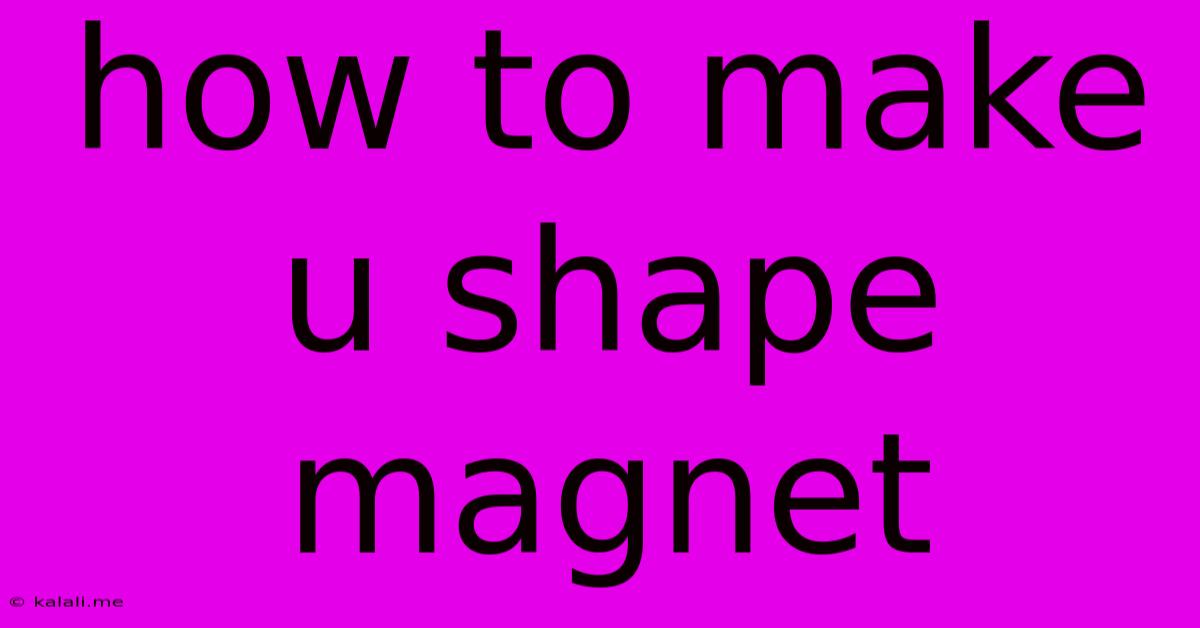How To Make U Shape Magnet
Kalali
Jun 11, 2025 · 4 min read

Table of Contents
How to Make a U-Shaped Magnet: A Comprehensive Guide
Meta Description: Learn how to create a U-shaped magnet using readily available materials and simple techniques. This guide covers various methods, from bending a strong magnet to using electromagnetism. Discover the science behind it and tips for optimal results.
Creating a U-shaped magnet might seem like a complex undertaking, but it's surprisingly achievable with the right approach. This guide will walk you through several methods, explaining the science behind each and offering practical tips for success. Whether you're a science enthusiast, a DIYer, or simply curious, this guide provides a comprehensive understanding of how to craft your own U-shaped magnet.
Understanding Magnetism and U-Shaped Magnets
Before diving into the methods, it's crucial to understand the basics. Magnetism is a fundamental force of nature caused by the movement of electric charges. Materials like iron, nickel, and cobalt can become magnetized when their atoms align, creating a magnetic field. A U-shaped magnet, also known as a horseshoe magnet, concentrates this magnetic field at the poles, creating a stronger attraction at the gap between the poles. This configuration makes them particularly useful in various applications.
Method 1: Bending a Strong Magnet
This is the simplest method, but it requires a strong, flexible magnet. Important Note: Not all magnets are flexible. Attempting this with a brittle magnet will likely result in breakage.
- Materials: A strong, flexible magnet (neodymium magnets are generally too brittle), pliers or a vise (optional for added control).
- Process: Carefully bend the magnet into a U-shape. The degree of bend will depend on the flexibility of the magnet. Use pliers or a vise if needed to ensure a clean bend and avoid accidental breakage. Caution: Be mindful of the magnet's strength; it can easily pinch your fingers.
Limitations: This method is only suitable for inherently flexible magnets. Most commercially available strong magnets are not designed for bending.
Method 2: Magnetizing a U-Shaped Iron Core (Electromagnetism)
This method requires a bit more setup, but it allows you to create a U-shaped magnet from a piece of ferromagnetic material. This uses the principle of electromagnetism – generating a magnetic field using an electric current.
- Materials: A U-shaped iron core (easily obtainable from various sources; you can also fashion one from iron wire), insulated copper wire, a DC power supply (battery can work, but a higher voltage supply will generate a stronger magnetic field), and potentially an ammeter to monitor current flow.
- Process: Wrap the insulated copper wire tightly around each leg of the U-shaped iron core, ensuring the windings are consistent in direction. Connect the ends of the wire to the DC power supply. The current flowing through the wire generates a magnetic field, magnetizing the iron core. The strength of the magnet will be proportional to the number of windings and the current applied. Once the current is turned off, the iron core will retain some magnetism, though its strength might not be as substantial as other magnet types.
Limitations: The resulting magnet's strength might be less than commercially produced magnets. Experimentation might be necessary to find the optimal number of wire windings and current for the strongest magnetic field.
Method 3: Assembling Smaller Magnets
This involves strategically arranging smaller magnets to create the U-shape.
- Materials: Multiple smaller, strong magnets (e.g., neodymium magnets) and a strong adhesive (epoxy is recommended).
- Process: Carefully arrange the smaller magnets in a U-shape, ensuring the poles are aligned correctly to enhance the magnetic field. Secure the arrangement using a strong adhesive.
Limitations: This method requires precision in arranging the magnets to ensure correct polarity and stability. The strength of the resulting magnet depends on the strength and number of individual magnets.
Tips for Optimal Results
- Material Selection: Choose high-quality materials. For electromagnetism, ensure the iron core is pure and the copper wire is properly insulated.
- Safety Precautions: Always handle magnets with care, as they can pinch or cause injury. Be cautious when working with electricity.
- Experimentation: Don't be afraid to experiment with different materials and methods. The best results often come from trial and error.
Creating a U-shaped magnet offers a rewarding hands-on experience and a deeper understanding of magnetism. While the methods above provide a good starting point, remember that experimenting and refining your technique is key to achieving the best results. Remember to always prioritize safety when working with magnets and electricity.
Latest Posts
Latest Posts
-
Which Of The Following Is Not A Nucleotide
Jun 12, 2025
-
How Many People Are In A Basketball Team
Jun 12, 2025
-
How Many Overs Can A Bowler Bowl In T20
Jun 12, 2025
-
What Is A Split Phase Motor
Jun 12, 2025
-
What Is The Difference Between Certified And Registered Mail
Jun 12, 2025
Related Post
Thank you for visiting our website which covers about How To Make U Shape Magnet . We hope the information provided has been useful to you. Feel free to contact us if you have any questions or need further assistance. See you next time and don't miss to bookmark.